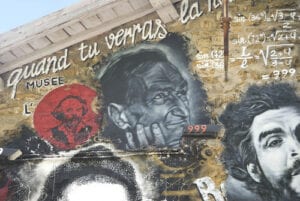January 21, 2020 | by Tom Winchester

Jordan Kriseman recently graduated from the University of Florida, where she majored in Art History and minored in Sustainability Studies. This Friday, The Dalí Museum will be presenting Kriseman’s pre-recorded lecture on Vincent Van Gogh titled Madness, Genius, and the Oeuvre as the first of its Young Scholars Lecture Series.
The presentation sheds new light on the influences of the Surrealists, and paints a new picture of Van Gogh.
Jordan Kriseman: Last summer, I interned at the Dalí Museum under the supervision of the Executive Director, Dr. Hank Hine. During the course of the internship, I researched and wrote a paper about connections between Van Gogh and Surrealism in anticipation of the exhibition currently on view titled, Van Gogh Alive. Because we usually might not think of any connections between Van Gogh and Surrealism, I approached this topic throughout the question of art and madness.
I had recently written my honor’s thesis at the University of Florida about art and madness, as it related to Van Gogh, looking at two figures of the avant-garde in France – (theatremaker) Antonin Artaud and (filmmaker) Alain Resnais. So, I was familiar with this question of art and madness as it related to Van Gogh.
I also knew that the Surrealists, and some of the other artists working at that time, did have an interest in madness and the work of psychiatric patients. Toward the end of that internship, Dr. Hine requested that I present this research once the Van Gogh Alive exhibition opened.

Tom Winchester: Is there a specific definition for madness?
JK: I learned about this relationship between art and madness through a graduate seminar that I took. From that seminar I learned that, through the late 1800s and into the early 1900s, there was a lot of work being done in psychiatric institutions with madness, but they didn’t know how to define or diagnose different mental illnesses. Also, women were being labeled ‘hysterical,’ so that was being called madness. So, for my honor’s thesis and the paper for the Dalí, I didn’t specifically try to redefine madness. Rather, I worked with how artists and people in the early 20th century would’ve thought of it.
In the case of Van Gogh, retrospectively, people try to diagnose him as schizophrenic or bipolar, which I don’t think is beneficial. Instead of trying to do that, I refer to it as madness. The Surrealists understood madness, especially as it related to psychiatric patients of the time, as a radical experiential reality.
So, I look at how Van Gogh approached reality in his painting. Also, I look at the idea of being a genius, and how that relates to reality.
The Surrealists didn’t necessarily look to Van Gogh for inspiration, although they would have known of his work and would have seen his paintings. It’s an interesting point because themes like the creation of a reality within a painting, and the idea of genius, which are characteristic of Van Gogh’s work, made their way into Surrealism.
TW: Will you be speaking about any artists in addition to Van Gogh?
JK: The presentation is mainly about Van Gogh, but I do mention a number of other artists. There was a book published in 1922 by Hans Prinzhorn, who was a German art historian and psychiatrist, called, Artistry of the Mentally Ill, in which he details some artworks of patients of his who began making art once they were in the psychiatric hospital.
A number of artists, including some Surrealists, were really interested in that book and the artworks the patients produced. I mention Paul Klee, Max Ernst, Jean Dubuffet and Dalí, as examples of artists who drew inspiration from that book.
I don’t mention Artaud in this paper as much as I did in my thesis, but I include him because of his interest in Van Gogh, and because he was in psychiatric hospitals for almost a decade.
TW: Who are the art historians who inspire you?
JK: There are a lot of art historians and scholars who I think of as influential, and who I read as someone who’s interested in modern and contemporary art. They include Hal Foster, Rosalyn Deutsche and Benjamin Buchloh.
. . .
But I would love to be a scholar like the professor who supervised my honor’s thesis, Dr. Kaira Cabañas. I took my first class with her when I was a freshman and throughout my time at UF, I took, I think, five courses with her, including two seminars. I was able to work with her a lot, and I really respect her as a scholar and an art historian.

TW: What would you like to research next?
JK: Going forward, I see myself researching land art, and things more related to the environment, and interacting with nature. I’m interested in the land art movement of the 1960s and ‘70s.
TW: Classically, art historians trace the events of the past, and rarely give their opinions on the meanings of artworks. As an art historian, do you see yourself giving your opinions as well?
JK: It depends on the context. My academic writing is still in that more traditional vein of writing the history without giving my opinion. But I think people around my age are wanting to change that a bit.
In terms of what I’m doing right now, one of my friends and I started a podcast called, MaJor Musings, where we’re talking about art and artists we find interesting. We’re trying to bring an informational side, but also an informal and conversational side so people who aren’t academics can still access it, and still find it interesting without using jargon. We’re basically just telling each other about new artists, giving our opinions and explaining why we enjoy the work so much.
Of course, a podcast is different than writing a thesis or dissertation, but I think the lines are starting to blur a little bit more. Slowly, but surely.





